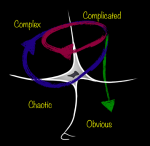
The Cynefin Framework with the newly renamed ‘Obvious’ domain (formerly ‘Simple’). Source: Cognitive Edge
In the Cynefin framework, complex and chaotic are two separate domains. Complexity is defined as the domain where agents and constraints co-evolve, chaos as where there are no constraints. Both are part of the unordered side of Cynefin, i.e. where events are unpredictable and expert knowledge and analysis are not leading to better decisions. Chaos is seen as a domain where you don’t really want to be, so all you have to do there is go act quickly and decisively to get out. To use Dave Snowden’s words: “Chaos is a transitionary domain. (…) If you collapse into it without [intention] then the strategy is to move out in a controlled way; you will move out as constraints happen naturally. Entered deliberately it can create the conditions for radical innovation, used as contained chaos it allows for distributed cognition or Wisdom of Crowds. Nothing resides in Chaos for any period without sustained effort.”
Now there has been some controversy in the blogsphere on the use of the term ‘chaos.’ What is the distinction between complexity and chaos? Some use the term very much interchangeably with complex, i.e. to describe human systems like the traffic in Hanoi or interactions of people within a company. This does not feel right to me as the definition of the complex domain from Cynefin very much resonates with my own understanding.
Chaos
I was starting with Chaos Theory, as this seems to me somehow a good start to learn about chaos from a scientific perspective. Chaos theory studies a particular kind of dynamical systems that seem to be rather clearly defined, at least what I could discern as a layman from the Wikipedia article on Chaos Theory (although also this article states that there is no universally accepted mathematical definition of chaos). A dynamic system must have three properties in oder to be called ‘chaotic’ in a mathematical sense:
- it must be sensitive to initial conditions;
- it must be topologically mixing; and
- its periodic orbits must be dense.
The interesting part here really is that chaotic systems at least in the mathematical sense are deterministic. This means that their future behaviour is fully determined by their initial conditions, with no random elements involved (hence, they are, at least in theory, fully predictable). Edward Lorenz’s definition of chaos (Lorenz was one of the pioneers in chaos theory): “Chaos is when the present determines the future, but the approximate present does not approximately determine the future.”
One important note here: chaotic systems do not depend on the past, they have no history that matters for their future behaviour, as they are fully determined by the presence (i.e. the initial conditions).
So this seems to be at odds with the use of chaos in the Cynefin framework, as there the chaotic domain is surely not a deterministic domain. The chaotic domain in Cynefin is rather comparable with randomness, as there are no constraints whatsoever in place, i.e. anything can happen and the future is fully unpredictable. That is why, I suppose, Dave muses (same blog post as liked above) about changing the name of the domain. I’m curious …
Complexity
Now complex systems seem to be a different pair of shoes as they are more difficult to pin down. A plethora of schools and disciplines can be subsumed under the so-called complexity sciences. Nevertheless, complexity theory is rooted in chaos theory (see Wikipedia on Complex Systems and Chaos Theory) but complex systems are in a very important way different from chaotic systems as they are described above: complex systems are non-deterministic, i.e. there is no way we can precisely predict their future state, even if we knew the current ‘initial conditions.’ So complexity is located as a domain between deterministic order and randomness (here, chaos is seen as a special variant of ‘order’, i.e. ‘chaotic order’, in contrast to what we traditionally call ‘order’, i.e. equilibrium).
In complex systems, history matters – much more than initial conditions. The constraints in a complex system evolved over time through the interaction of the agents in the system and are, hence, a recording or the evolutionary history of the system.
Complex systems are made up of a variety of interconnected and interdependent entities. Melanie Mitchell defines a complex system in her book ‘Complexity: A Guided Tour’ as follows: “a system in which large networks of components with no central control and simple rules of operation give rise to complex collective behavior, sophisticated information processing, and adaptation via learning or evolution.”
Now while I like Mitchell’s definition, there is only one aspect that I’m at odds with: the simple rules of operation. This might be true for ants in a colony or cells in the brain, which are also complex systems. But this is not necessarily true when humans interact, as their rules of operation are in themselves highly complex. But this is a topic for another post.

Hanoi Traffic. Source: Wikimedia. Photograph by Greg Willis
What I want to close with is an example of a complex system that is often described as chaotic: traffic in crowded cities of Asia like Hanoi, particularly if there are many motorcycles or tuktuks involved. Apparently, there are no rules, so the scene is clearly chaotic in a colloquial sense, especially for a Westerner’s eye. But looking at it in more detail, there are a number of fundamental rules or constraints at play (e.g. ‘don’t drive into another vehicle’), which enable the traffic to keep flowing in a complex and unpredictable way. If the situation were truly chaotic, everyone would bump into everyone, making travel impossible.
Conclusion
I did not do a full literature review. Equally, I still see myself as an explorer of the field of complexity, particularly of applying complexity in development, and not as an expert. Nevertheless, my conclusion from this little geeky excursion would be that the chaotic domain in Cynefin is very valuable, particularly as described in Dave’s writing on Cynefin, but that I don’t necessarily agree with the name of the domain. While what Dave describes as the complex domain is very much matching with what I interpret as complex systems based on my explorations into this literature, this is not true for the chaotic domain. At the same time, when I read other texts in fields of business management or enterprise design, I see that the term chaos is used in a sense that very much means the same as complexity, but not as chaos is defined in scientific terms. I think it is important to use consistent language to describe these things, otherwise the resulting frameworks are more confusing than helpful.
